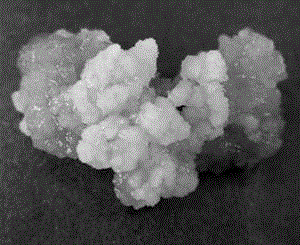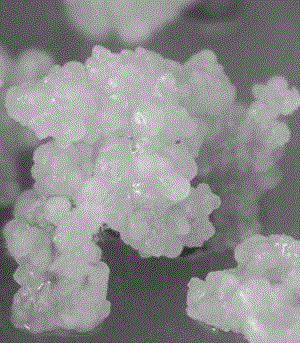Somatic embryo in-vitro regeneration method applied to genetic transformation and seed ball rapid propagation of Lilium pumilumDC. Fisch
A technology of genetic transformation and somatic embryos, applied in botany equipment and methods, plant regeneration, horticultural methods, etc., can solve problems such as thin and weak stems, and achieve the effects of increased germination rate, high regeneration efficiency, and good preservation effect
- Summary
- Abstract
- Description
- Claims
- Application Information
AI Technical Summary
Problems solved by technology
Method used
Image
Examples
example 1
[0036] Example 1. In Vitro Regeneration Technology of Lilium microphylla Somatic Embryos
[0037] 1. Non-embryogenic callus induction stage (explant dedifferentiation stage)
[0038] Select aseptic seedlings of Lilium microphyllum with a small bulb diameter of 1-1.2 cm, cut the leaves into 0.5 cm long segments, inoculate them on the dedifferentiation medium MS+BA 1.0 mg·L with the front facing up -1 +NAA 0.5 mg L -1 (ie BA / NAA is 2), light culture. Contains 30 g·L of sucrose -1 , agar (bar) 7 g·L -1 , pH 5.8, autoclaved at 121°C for 20 minutes. The temperature of the culture room is 25±1°C, and an airtight sealing film is used to ensure that the humidity in the tissue culture bottle reaches 80-90%, with 16 hours of light and 8 hours of darkness every day, and the light intensity is 36 μmol m -2 ·s -1 .
[0039] In the experiment, it was found that if the scales were used as explants, the direct regeneration of adventitious buds would occur. However, adventitious buds d...
example 2
[0057] Example two, identification of non-embryogenic callus and embryogenic callus
[0058]Observation by stereomicroscope showed that non-embryogenic callus had smooth surface, while embryogenic callus had tumor-like structure. Observation of paraffin sections showed that there were obvious differences between the two types of callus, and there was no obvious cell structure in the non-embryogenic callus (see appendix Figure 13 ), while the embryogenic callus is mostly of external origin, the internal cell structure is obvious, and most of them are spherical. From the inner layer to the outer layer, the cells gradually become smaller and more closely arranged (see appendix Figure 14 ).
example 3
[0059] Example 3. Validation of the Efficiency of the Somatic Embryogenesis Pathway
[0060] Although the somatic embryo regeneration system has the advantages of single-cell origin and high reproduction coefficient, due to the relative difficulty of induction, only a few species of lilies at home and abroad can obtain somatic embryos, and most of them are cut flower varieties. Many wild lilies are rarely reported. At present, the research on the in vitro regeneration of Lilium tenifolia mainly focuses on the organogenesis pathway. When the scales of Lilium tenifolia (taken from adult bulbs, not sterile seedlings) are used as explants for adventitious bud induction, the induction coefficient is 3- 4.8; using lily lily filaments as explants, the callus induction rate is 40%, and when the callus undergoes adventitious bud differentiation, the differentiation coefficient is 10.8 (Jin Shumei et al., 2006; Ge Beibo et al., 2010); in other In the research on somatic embryogenesis o...
PUM
 Login to view more
Login to view more Abstract
Description
Claims
Application Information
 Login to view more
Login to view more - R&D Engineer
- R&D Manager
- IP Professional
- Industry Leading Data Capabilities
- Powerful AI technology
- Patent DNA Extraction
Browse by: Latest US Patents, China's latest patents, Technical Efficacy Thesaurus, Application Domain, Technology Topic.
© 2024 PatSnap. All rights reserved.Legal|Privacy policy|Modern Slavery Act Transparency Statement|Sitemap



